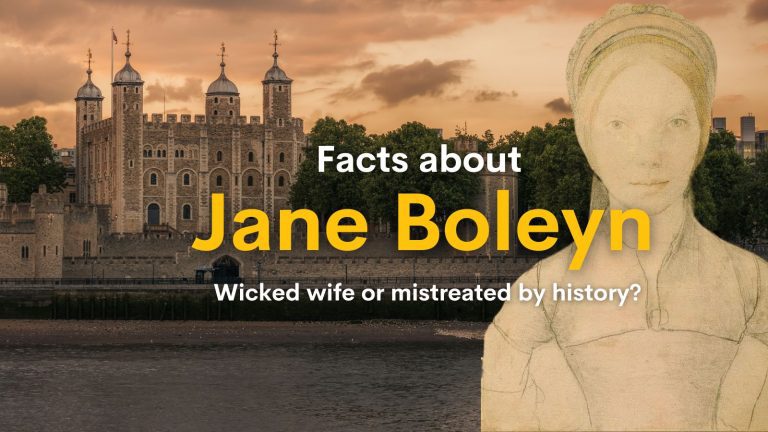Why did Henry VIII kill his wives
[et_pb_section fb_built=”1″ _builder_version=”4.15″ _module_preset=”default” min_height=”612px” global_colors_info=”{}”][et_pb_row _builder_version=”4.15″ _module_preset=”default” global_colors_info=”{}”][et_pb_column type=”4_4″ _builder_version=”4.15″ _module_preset=”default” global_colors_info=”{}”][et_pb_text _builder_version=”4.15.0″ _module_preset=”default” global_colors_info=”{}”]
Henry VIII of England famously married six times. He is known for ruthlessly disposing of his wives when they failed to give him what he wanted… a son.
There are plenty of kings that killed their wives. Henry VIII was not unique in the world. However, he is the most famous.
Of course, not all of Henry 8th’s wives were killed.
How many wives did Henry VIII Kill?
Henry VIII killed two of his six wives. Anne Boleyn and Catherine Howard were both beheaded after being found guilty of treason.
So why did Henry VIII turn to the executioner instead of going through the legal process and divorcing his wives? After all, both Catherine of Aragon and Anne of Cleves had both been divorced.
Firstly, we should address a technicality. The word “divorce”, as we understand it, shouldn’t be used when it comes to how Henry’s marriages ended. The correct term was an annulment.
Both his marriage to Catherine of Aragon and Anne of Cleves were annulments. It was as though the marriage never even happened, which is different from a modern-day divorce. This was why when Catherine of Aragon was buried; it was as Dowager Princess of Wales (her title, from her marriage to Prince Arthur) as opposed to Queen of England.
Before their executions both Anne Boleyn and Catherine Howard suffered the same fate, their marriages were both annulled. Hence, Princess Elizabeth (Anne Boleyn and Henry VIII’s daughter) was then considered illegitimate and was referred to as the Lady Elizabeth.
Henry had four annulments, so technically, it could be argued that Henry VIII only married twice, once to Jane Seymour and then to his final wife, Catherine Parr, who outlived him.
So why did Henry VIII turn to executions if an annulment had already happened?
[/et_pb_text][/et_pb_column][/et_pb_row][et_pb_row _builder_version=”4.15″ _module_preset=”default” global_colors_info=”{}”][et_pb_column type=”4_4″ _builder_version=”4.15″ _module_preset=”default” global_colors_info=”{}”][et_pb_image src=”http://historywithhenry.com/wp-content/uploads/2021/09/Anne_Boleyns_Execution_by_Jan_Luyken.jpg” alt=”Beheading of Anne Boleyn” title_text=”Anne_Boleyn’s_Execution_by_Jan_Luyken” align=”center” _builder_version=”4.15″ _module_preset=”default” global_colors_info=”{}”][/et_pb_image][/et_pb_column][/et_pb_row][et_pb_row _builder_version=”4.15″ _module_preset=”default” global_colors_info=”{}”][et_pb_column type=”4_4″ _builder_version=”4.15″ _module_preset=”default” global_colors_info=”{}”][et_pb_text _builder_version=”4.15″ _module_preset=”default” global_colors_info=”{}”]
Why did Henry VIII execute Anne Boleyn?
[/et_pb_text][/et_pb_column][/et_pb_row][et_pb_row _builder_version=”4.15″ _module_preset=”default” global_colors_info=”{}”][et_pb_column type=”4_4″ _builder_version=”4.15″ _module_preset=”default” global_colors_info=”{}”][et_pb_text _builder_version=”4.15″ _module_preset=”default” global_colors_info=”{}”]
The second wife of Henry VIII, Anne Boleyn, was found guilty of high treason on 15th May 1536. She was executed on Tower Green four days later, by a specialist swordsman from France who beheaded her with a single stroke.
At first glance, this seems an extraordinary decision. After all, Henry had recently moved heaven and earth in order to marry Anne Boleyn.
It took him two years to get the annulment of his marriage to Catherine of Aragon, and in the process, he broke from the Church of Rome and was excommunicated. He lost friends and supporters along the way.
What had now happened that had caused Henry’s wrath that he would send the woman he had once loved to her death?
There was a multitude of factors at play.
Firstly, there is the argument that Anne Boleyn had failed to deliver Henry what she had promised… a son.
Anne had given birth to one live daughter, the future Elizabeth I. She had also suffered two miscarriages. The final one, being just a matter of months before her downfall.
But was this the reason Henry VIII executed her?
A lot of the qualities that Anne possessed, her wit, intelligence, outspokenness, and sharp tongue, were things that Henry found attractive when he was pursuing her. However, now that she was Queen, Henry’s view was that she should shut up, sit at his side, and nod her head at the appropriate point.
So the qualities that worked in her favour while Henry was wooing her now worked against her. Quite frankly, Henry was a little bit fed up with her.
Then Henry’s eye fell on the young, attractive Jane Seymour. Jane didn’t have Anne’s education or worldly experience, and most importantly, she wasn’t outspoken.
Henry was a man that was used to having affairs. Whenever his wives fell pregnant, he normally embarked on another affair. The vast majority of the time, we don’t know the identities of these particular mistresses. There are only two that we know of; his long-term mistress Bessie Blount and Mary Boleyn, the sister of Anne, with who he had an affair while he was still married to Catherine of Aragon.
Again, this was another point of contention with Anne. Catherine of Aragon would simply look the other way. Anne didn’t. At one point, Henry told her, “Close your eyes and endure, as your betters have done.”
At some point, Henry decided that Jane Seymour would be a better bet as Queen. There were just three months between Anne’s final miscarriage and her downfall so that it would have been within that timeframe.
[/et_pb_text][/et_pb_column][/et_pb_row][et_pb_row _builder_version=”4.15″ _module_preset=”default” global_colors_info=”{}”][et_pb_column type=”4_4″ _builder_version=”4.15″ _module_preset=”default” global_colors_info=”{}”][et_pb_text _builder_version=”4.15″ _module_preset=”default” global_colors_info=”{}”]
How could Henry marry Jane Seymour?
[/et_pb_text][/et_pb_column][/et_pb_row][et_pb_row _builder_version=”4.15″ _module_preset=”default” global_colors_info=”{}”][et_pb_column type=”4_4″ _builder_version=”4.15″ _module_preset=”default” global_colors_info=”{}”][et_pb_text _builder_version=”4.15″ _module_preset=”default” global_colors_info=”{}”]
This left him with a problem. How could he get rid of Anne Boleyn? After all, he divorced just one wife three years before. Were the people of the country going to accept him divorcing another?
I doubt that was a factor in Henry’s consideration. The people of England had never really taken to Anne Boleyn. They disliked her because they loved Catherine of Aragon. They believe that the King should have stayed married to Catherine, who he had been married to for twenty years.
There is a question of who was actually behind Anne Boleyn’s downfall?
There is an argument that there was a growing power struggle between Anne Boleyn and Henry’s chief adviser, Thomas Cromwell. They both wanted Henry’s ear.
Could it have been that Thomas Cromwell reached a point where he knew it would be Anne or him? So in an act of self-survival, Cromwell engineered Anne’s downfall.
There is no doubt that he was behind the construction of the charges. The question is, did he instigated them himself, or did Henry come to him on a dark and stormy night and say, “I want rid of this woman. Do what you need to do.”
It’s a question that will probably never be answered.
Cromwell was only too aware that Anne would never agree to a divorce. He wasn’t about to go through another lengthy process to secure the King one. He had to find another way.
Cromwell got to work in his usual Machiavellian way. He arrested seven men that he accused of sleeping with Anne Boleyn. Five subsequently went on trial and were found guilty (Two were released without charge.)
Anne herself was arrested and was also found guilty of these crimes.
To add another layer of scandal to these charges, Thomas Cromwell arrested a court musician, Mark Smeaton. The Queen of England, lowering herself to sleeping with a court musician would have been considered outrageous in Tudor England. Finally, to compound the scandal a further stage Cromwell arrested, George Boleyn, Anne’s brother. So there was now a charge of incest thrown in for good measure.
[/et_pb_text][/et_pb_column][/et_pb_row][et_pb_row _builder_version=”4.15″ _module_preset=”default” global_colors_info=”{}”][et_pb_column type=”4_4″ _builder_version=”4.15″ _module_preset=”default” global_colors_info=”{}”][et_pb_blurb title=”Anne Boleyn in the Tower” image=”http://historywithhenry.com/wp-content/uploads/2021/09/Anne_Boleyn_London_Tower-1.jpg” alt=”Anne Boleyn arrested in the Tower” _builder_version=”4.15″ _module_preset=”default” global_colors_info=”{}”]
Painting by Édouard Cibot
[/et_pb_blurb][/et_pb_column][/et_pb_row][et_pb_row _builder_version=”4.15″ _module_preset=”default” global_colors_info=”{}”][et_pb_column type=”4_4″ _builder_version=”4.15″ _module_preset=”default” global_colors_info=”{}”][et_pb_text _builder_version=”4.15″ _module_preset=”default” global_colors_info=”{}”]
Was Anne Boleyn guilty of the charges?
[/et_pb_text][/et_pb_column][/et_pb_row][et_pb_row _builder_version=”4.15″ _module_preset=”default” global_colors_info=”{}”][et_pb_column type=”4_4″ _builder_version=”4.15″ _module_preset=”default” global_colors_info=”{}”][et_pb_text _builder_version=”4.15″ _module_preset=”default” global_colors_info=”{}”]
If we think about it, all of these charges would have been ludicrous.
Her ladies in waiting always accompanied the Queen of England. One or two even slept in the same bedroom as her as a means of security, and she would never have been left alone.
There was no opportunity for her to embark on an affair.
We can probably accept that Anne was innocent because she insisted that Sir William Kingston be present at her final confession with Archbishop Thomas Cranmer, the Constable of the Tower. He reported back to Cromwell and the King that Anne Boleyn did not confess her guilt.
Such was the emphasis on religion back in Tudor England; there is little doubt that if Anne were guilty, she would have confessed her sin to Cranmer before her death. The fact that she’d invited William Kingston to sit and listen to that confession meant that she wanted that information to get back to Henry. She wanted him to know that she was innocent.
As ridiculous as the charges appear to us today, people in Tudor England were only too inclined to believe the worst.
The charges were sufficiently scandalous to ensure that the court and the population of England had no hesitation in agreeing with the fact that she should be executed. According to the law, she had committed high treason against the King; she had put the line of succession in jeopardy.
On the 19th of May 1536, an executioner especially shipped in from France beheaded Anne Boleyn on Tower Green with one blow of his sword.
[/et_pb_text][/et_pb_column][/et_pb_row][et_pb_row _builder_version=”4.15″ _module_preset=”default” global_colors_info=”{}”][et_pb_column type=”4_4″ _builder_version=”4.15″ _module_preset=”default” global_colors_info=”{}”][et_pb_image src=”http://historywithhenry.com/wp-content/uploads/2021/10/The-Downfall-of-Anne-Boleyn-1536-1.png” alt=”The Downfall of Anne Boleyn” title_text=”The Downfall of Anne Boleyn 1536 (1)” _builder_version=”4.15″ _module_preset=”default” global_colors_info=”{}”][/et_pb_image][/et_pb_column][/et_pb_row][et_pb_row _builder_version=”4.15″ _module_preset=”default” global_colors_info=”{}”][et_pb_column type=”4_4″ _builder_version=”4.15″ _module_preset=”default” global_colors_info=”{}”][et_pb_text _builder_version=”4.15″ _module_preset=”default” global_colors_info=”{}”]
Why Did Henry VIII execute Catherine Howard?
[/et_pb_text][/et_pb_column][/et_pb_row][et_pb_row _builder_version=”4.15″ _module_preset=”default” global_colors_info=”{}”][et_pb_column type=”4_4″ _builder_version=”4.15″ _module_preset=”default” global_colors_info=”{}”][et_pb_text _builder_version=”4.15″ _module_preset=”default” global_colors_info=”{}”]
Catherine Howard, The fifth wife of Henry VIII was found guilty of treason as she had an affair with Thomas Culpepper, Gentleman of the Privy Chamber. In addition, she did not disclose prior relationships before she married the king. She was beheaded on Tower Green on February 13, 1542.
Catherine Howard was young and pretty, whereas Henry VIII was in his late forties, hugely obese, and had a rotting leg. It wasn’t exactly a match made in heaven for Catherine.
After she’d married the King, she was attracted to one of his Gentlemen of the Privy Chamber, Thomas Culpepper, a distant cousin of hers.
At some point during, or slightly before, the Northern progress of 1541, she began having an affair with him.
As we’ve already discussed in this article, it was complicated for the Queen of England to have an affair. After all, a lady in waiting would always sleep in the Queen’s bed-chamber at night as a matter of security.
Catherine Howard was assisted in this affair by one of her ladies in waiting, Jane Rochford, the sister-in-law of Anne Boleyn. Jane Rochford helped facilitate the meetings between Catherine Howard and Thomas Culpepper. Often these meetings would take place late at night when the entire court was asleep. It remains unclear what Lady Rochford’s motivation for helping the lovers was. It makes little sense, considering the possible consequences. Where was the benefit to her?
Meanwhile, back in London rumours, were coming to the attention of the Archbishop of Canterbury Thomas Cranmer about Catherine Howard’s past.
[/et_pb_text][/et_pb_column][/et_pb_row][et_pb_row _builder_version=”4.15″ _module_preset=”default” global_colors_info=”{}”][et_pb_column type=”4_4″ _builder_version=”4.15″ _module_preset=”default” global_colors_info=”{}”][et_pb_text _builder_version=”4.15″ _module_preset=”default” global_colors_info=”{}”]
Thomas Cranmer’s Investigation into Catherine Howard
[/et_pb_text][/et_pb_column][/et_pb_row][et_pb_row _builder_version=”4.15″ _module_preset=”default” global_colors_info=”{}”][et_pb_column type=”4_4″ _builder_version=”4.15″ _module_preset=”default” global_colors_info=”{}”][et_pb_text _builder_version=”4.15″ _module_preset=”default” global_colors_info=”{}”]
She was placed into the wardship of the Dowager Duchess of Norfolk, who looked after many young girls in a finishing school. Looking back at the evidence, it is clear that these young girls were what we would term sexually groomed by numerous male visitors. Her music teacher, Henry Maddox, abused her, and Catherine said later that he had touched her private parts.
Then she became involved with a man called Francis Dereham, who was secretary to the Dowager Duchess.
The relationship with Francis Dereham went so far that they referred to each other as man and wife. There’s a possibility that there was a pre-contract of marriage.
Catherine then started attending court as a lady in waiting to Anne of Cleves, and the relationship ended.
Stupidly, Catherine Howard granted Francis Dereham the position of her private secretary once she had become Queen of England. Dereham was known to be an extravagant, drunken loudmouth. Probably, he said too much about his past. Now some of these rumours had managed to reach Thomas Cranmer, who started his investigations.
On the second of November 1541, Henry VIII found an anonymous note waiting for him in his pew at The Chapel Royal at Hampton Court.
The letter explained Catherine’s history and conduct. Henry was shocked at the contents, and he refused to believe it. However, he instructed Cranmer to investigate further. Francis Dereham was arrested and confessed that he had been Queen Catherine’s lover.
Now, attention fell on Thomas Culpepper.
A love letter was discovered, written by Catherine to Culpeper. The phrasing in it was enough to incriminate her, ‘It makes my heart die to think I cannot be always in your company’. She signed off with the words, “Yours as long as life endures.” It was enough to send them both to the block.
Henry was hurt and humiliated. He had been obsessed with Catherine Howard and believed that she had loved him and him alone.
Now it was time for vengeance.
[/et_pb_text][et_pb_blurb title=”Catherine Howard’s Letter To Thomas Culpepper ” image=”http://historywithhenry.com/wp-content/uploads/2021/09/CatherineHowardLetter.jpg” alt=”Catherine Howard letter to Thomas Culpepper” _builder_version=”4.15″ _module_preset=”default” global_colors_info=”{}”]
It is the only remaining letter in Catherine Howard’s hand. It signed her own death warrant.
[/et_pb_blurb][/et_pb_column][/et_pb_row][et_pb_row _builder_version=”4.15″ _module_preset=”default” global_colors_info=”{}”][et_pb_column type=”4_4″ _builder_version=”4.15″ _module_preset=”default” global_colors_info=”{}”][et_pb_text _builder_version=”4.15″ _module_preset=”default” global_colors_info=”{}”]
Henry VIII’s Revenge
[/et_pb_text][/et_pb_column][/et_pb_row][et_pb_row _builder_version=”4.15″ _module_preset=”default” global_colors_info=”{}”][et_pb_column type=”4_4″ _builder_version=”4.15″ _module_preset=”default” global_colors_info=”{}”][et_pb_text _builder_version=”4.15″ _module_preset=”default” hover_enabled=”0″ global_colors_info=”{}” sticky_enabled=”0″]
Francis Dereham had committed no crime. He had not had a relationship with Catherine while she was married to the King. So Henry decided to change that. The law was retrospectively altered so that it became a capital offence to have “knowledge” of the Queen of England before the King.
Culpepper and Dereham were executed at Tyburn on the 10th December 1541. Culpepper had his sentence commuted to a mere beheading. Dereham suffered the full horrors of being hung, drawn, and quartered.
The execution of Catherine Howard, who had formally lost her title as Queen, took place on 13th February 1542 in the private location of Tower Green. Lady Rochford had gone mad since her imprisonment. Once more, Henry showed his vengeful side. The law stated that those declared insane could not be executed. Henry overturned that law so that Jane Rochford could be beheaded alongside her mistress.
The night before her execution, Catherine Howard called for the Constable of the Tower and requested that she be bought the block on which she would be executed the next day. She wanted to practice laying her head upon it so that she could get it just right in the morning.
There is a legend that as part of her final speech, Catherine Howard stated that “she dies a queen, but rather would die Culpepper’s wife.” That almost certainly never happened.
[/et_pb_text][et_pb_text _builder_version=”4.15.0″ _module_preset=”default” hover_enabled=”0″ sticky_enabled=”0″]
The arrest warrant of Catherine Parr
[/et_pb_text][et_pb_text _builder_version=”4.15.0″ _module_preset=”default” hover_enabled=”0″ sticky_enabled=”0″]
After Catherine Howard was executed, Henry married Lady Latimer, better known as Catherine Parr. She is famous for being the wife that survived King Henry VIII.
However, that was almost not the case.
An arrest warrant was drawn up for the arrest of Catherine Parr. The religious traditionalists in Henry VIII’s court were worried that Catherine Parr had radical views (they were right in that view.)
After a falling out between husband and wife where Catherine Parr was accused of lecturing her husband on religious matters, it appears that Henry agreed to an arrest.
However, the story goes that the warrant was purposely “lost”, and a member of Catherine’s household found it and brought it to the Queen. She then broke down in tears and was so upset the King had to be sent for. A reconciliation between Henry VIII and his spouse took place.
Catherine Parr came dangerously close to being the third of Henry 8th wives to be executed.
[/et_pb_text][/et_pb_column][/et_pb_row][/et_pb_section]






